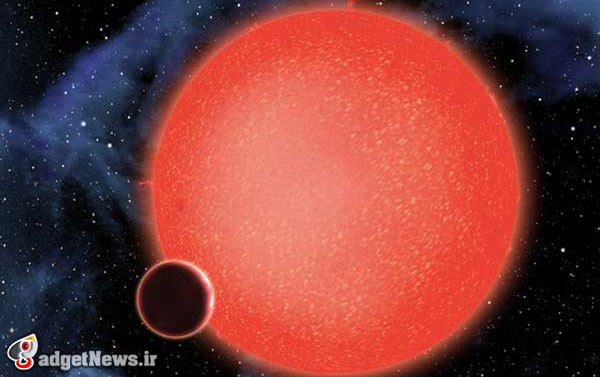
ستاره فرا خورشیدی (Exoplanet) که GJ 1214b نام گرفته است، یک سیاره بسیار گرم که بزرگتر از زمین است در مدار خود دارد، به لطف تلسکوپ هابل، ستارهشناسان موفق به پیدا کردن نشانههایی از ابر ضخیم در لایههای بالایی اتمسفر این سیاره شدند.
با توجه به تصاویر گرفته شده از تلسکوپ هابل، مطالبی در خصوص وجود ابر بر روی این سیاره منتشر شده و بحث و جدلها در این مورد بالا گرفته است. GJ 1214b که در سال ۲۰۰۹ برای اولین بار ثبت شد، یکی از چندین ستارههای ابر خورشیدی است که محققین امیدوار هستند تا نشانههایی از حیات در سایر منظومههای خورشیدی نیز پیدا کنند.
این ابرها قبلا به صورت بخار با غلظت پایین تشریح شده بودند که با تجمع گازها تفاوت زیادی داشتند و با توجه به مطالعات زیاد، باز هم دانشمندان در خصوص این اتمسفر به اجماع نظر نرسیدند. تصاویر گرفته شده توسط تلکسوپ هابل به شناسایی اطلاعات بیشتر در خصوص GJ 1214b کمک شایانی کرده است. سنسورهای تلسکوپ موفق به محاسبه میزان نوری که این سیاره در هنگام عبور از جلوی خورشید خود دریافت میکند، شدند و با مقایسه تفاوت میان نور معمولی و نور اینفرارد اطلاعات جدیدی را در خصوص گازهایی که ممکن است در محیط این سیاره وجود داشته باشد بدست آوردند.
تحقیقات اخیر مشخص کرده است که از اطلاعات بدست آمده دو نتیجه میتوان گرفت: ممکن است بخار آب و یا مولکولهای منبسط دیگری در اتمسفر این سیاره وجود داشته باشد و یا اینکه ابرهایی در ارتفاع بسیار بالا این سیاره را در برگرفته باشند و مشاهده محیط داخل سیاره از بیرون ممکن نباشد.
برای روشن نمودن قضیه، دانشمندان به رهبری لورا کریدبرگ (Laura Kreidberg) و جاکوب بین (Jocob Bean) از دانشگاه شیکاگو اقدام به محاسبه دقیق نور اینفرارد با استفاده از تصاویر تلسکوپ هابل کردند. حدود ۹۶ ساعت اطلاعات در یازده ماه توسط این تلسکوپ جمعآوری گردید. کمبود مواد شیمیایی نشان داده شده در آزمایشات میتواند نمایانگر بخارهای آب و یا نیتروژن سیار در هوا باشد، کریدبرگ و بین معتقد هستند که این بخار فضای بالای اتمسفر این سیاره را مثل پتو پوشانده است! البته این محققین هنوز موفق به تشخیص جنس ابرها نشدهاند، ممکن است این ابرها از پتاسیوم کلراید و یا زینک سولفید تشکیل شده باشد.
به گفته کریدبرگ: البته ممکن است با انواع متفاوتی از ابر به نسبت آنچه انتظار داریم روبرو شویم. آگاهی ما نسبت به اتمسفر سیاره میتواند نظریات قبلی را در خصوص این سیاره تغییر دهد، وجود مایعات زیاد باعث مختل شدن دید خواهد شد.
در حال حاضر این گروه دانشمندان معتقد هستند که تلسکوپ هابل با انجام این تحقیقات، کار بزرگی انجام داده است و نکته جالب توجه این است که تلسکوپ هابل هرگز برای انجام چنین آزمایشاتی ساخته نشده و آزمایشهای انجام شده توسط تلسکوپ هابل از دقت بسیار بالایی برخوردار بوده است.
به گفته بیم: با این آزمایشها آنها میتوانند سیارات کوچکی را که به دور خورشید خود در خارج از منظومه شمسی حرکت میکنند را شناسایی کنند.
تلسکوپ فضایی جیمز وب قرار است در سال ۲۰۱۸ به فضا پرتاب شود و انتظار میرود که از دقت بسیار بالاتری برخوردار باشد.
منبع : theverge
Hubble telescope finds evidence of clouds on a distant planet
40 light-years away lies the exoplanet GJ 1214b, a searingly hot "super-Earth" orbiting a red dwarf star. And thanks to the Hubble telescope, researchers believe they've found what lies in the planet's upper atmosphere: thick clouds. A paper, published in the January 2nd issue of Nature, relies on the telescope to settle a debate about the planet's composition. First documented in 2009, GJ 1214b is one of several exoplanets that researchers are studying in hopes of finding a habitable world in another solar system. It's been previously described as a "steamy waterworld," with a density too low to be purely rock and too high to be a gas giant. But despite years of study, researchers hadn't come to a conclusion about what kind of atmosphere enveloped it.
Footage from the Hubble telescope has been instrumental in figuring out anything about GJ 1214b. Its sensors measured light as the planet crossed in front of its star, using the differences in infrared and visible light to tease out what gases might be around it. Earlier studies pointed to two possible interpretations of this data: there could be a consistent atmosphere of water vapor or another heavy molecule, or high-altitude clouds could be enshrouding the planet and obscuring everything below. To clear up the question, researchers led by the University of Chicago's Laura Kreidberg and Jacob Bean used the Hubble to capture precise measurements of infrared light. Data captured in 96 hours of telescope use over 11 months showed a lack of the chemical fingerprints that would indicate a cloud-free steam of something like water or nitrogen, leading Kreidberg and Bean to conclude that clouds likely blanketed the upper atmosphere.
The researchers say they still don't know what the clouds are made of, though it could be potassium chloride or zinc sulfide. "You would expect very different kinds of clouds to form than you would expect, say, on Earth," says Kreidberg. Understanding more about the atmosphere could change previous conclusions about the planet's makeup: its watery composition becomes harder to verify if it's largely blocked from view. For now, the group believes it's also important that the Hubble was capable of performing this research at all. "I think it's very exciting that we can use a telescope like Hubble that was never designed with this in mind, do these kinds of observations with such exquisite precision, and really nail down some property of a small planet orbiting a distant star," says Bean. That level of precision will hopefully be improved upon by the Hubble's successor, the James Webb Space Telescope set to be launched in 2018.
 گجت نیوز آخرین اخبار تکنولوژی، علم و خودرو
گجت نیوز آخرین اخبار تکنولوژی، علم و خودرو 





